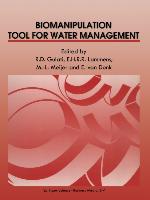Biomanipulation Tool for Water Management
BücherAngebote / Angebote:
One: Biomanipulation: Past, Present and Future.- Biomanipulation: retrospective and future development.- Biomanipulation: the next phase ¿ making it stable.- Two: Zooplankton¿Phytoplankton Interactions.- Are blue-green algae a suitable food for zooplankton? An overview.- Effectiveness of phytoplankton control by large-bodied and small-bodied zooplankton.- Analysis of phytoplankton¿zooplankton relationships in an oligotrophic lake under natural and manipulated conditions.- Biomanipulation by introduction of herbivorous zooplankton. A helpful shock for eutrophic lakes?.- The zooplankton¿phytoplankton interface in lakes of contrasting trophic status: an experimental comparison.- Why do cladocerans fail to control algal blooms?.- Structural and grazing responses of zooplankton community to biomanipulation of some Dutch water bodies.- Three: Enclosure Studies.- Biomanipulation and food-web dynamics ¿ the importance of seasonal stability.- Impact of whitefish on an enclosure ecosystem in a shallow eutrophic lake: selective feeding of fish and predation effects on the zooplankton communities.- Impact of whitefish on an enclosure ecosystem in a shallow eutrophic lake: changes in nutrient concentrations, phytoplankton and zoobenthos.- A fading recovery: the role of roach (Rutilus rutilus L.) in maintaining high phytoplankton productivity and biomass in Lake Vesij¿i, southern Finland.- Bottom-up effects of bream (Abramis brama L.) in Lake Balaton.- Applicability of planktonic biomanipulation: for managing eutrophication in the subtropics.- Four: Whole Lake Studies.- Conditions for effective biomanipulation, conclusions derived from whole-lake experiments in Europe.- Fish manipulation as a lake restoration tool in shallow, eutrophie temperate lakes 1: cross-analysis of three Danish case-studies.- Fish manipulation as a lake restoration tool in shallow, eutrophic, temperate lakes 2: threshold levels, long-term stability and conclusions.- Phytoplankton biomass reduction after planktivorous fish reduction in a shallow, eutrophie lake: a combined effect of reduced internal P-loading and increased zooplankton grazing.- Ecological consequences of a manual reduction of roach and bream in a eutrophic, temperate lake.- Predictability and possible mechanisms of plankton response to reduction of planktivorous fish.- Oligotrophication as a result of planktivorous fish removal with rotenone in the small, eutrophic, Lake Mosvatn, Norway.- Whole-lake food-web manipulation as a means to study community interactions in a small ecosystem.- First attempt to apply whole-lake food-web manipulation on a large scale in The Netherlands.- Is reduction of the benthivorous fish an important cause of high transparency following biomanipulation in shallow lakes?.- Early responses of plankton and turbidity to biomanipulation in a shallow prairie lake.- Effects of planktivorous fish mass mortality on the plankton community of Lake Mendota, Wisconsin: implications for biomanipulation.- Effects of planktivore abundance on chlorophyll-a and Secchi depth.- Factors related to variance of residuals in chlorophyll-total phosphorus regressions in lakes and reservoirs of Argentina.- Three years of experience in biomanipulating a small eutrophic lake: Lago di Candia (Northern Italy).- Five: Macrophytes.- Engineering and biological approaches to the restoration from eutrophication of shallow lakes in which aquatic plant communities are important components.- The potential of artificial refugia for maintaining a community of large-bodied cladocera against fish predation in a shallow eutrophic lake.- Ecosystem development in different types of littoral enclosures.- Can macrophytes be useful in biomanipulation of lakes? The Lake Zwemlust example.- Biomanipulation of Lago di Candia (Northern Italy): a three-year experience of aquatic macrophyte management.- Impact of mechanical deweeding on Dal lake ecosystem.- Proposals for macrophyte restoration in eutrophic coastal lagoons.- Six: Macrofauna.- Zebra mussels (Dreissena polymorpha): a new perspective for water quality management.- Shoals of Dreissena polymorpha as bio-processor of seston.- Evaluation of Chaoborus predation on natural populations of herbivorous zooplankton in a eutrophic lake.- Hydrophyte-macroinvertebrate interactions in Zwemlust, a lake undergoing biomanipulation.- Seven: Models.- Multiplicity of stable states in freshwater systems.- Quantifying the food webs of Lake Bleiswijkse Zoom and Lake Zwemlust.- Production, consumption and prey availability of northern pike (Esox lucius), pikeperch (Stizostedion lucioperca) and European catfish (Silurus glanis): a bioenergetics approach.- Growth and food consumption of vendace (Coregonus albula (L.)) in Lake Pyh¿rvi, SW Finland a bioenergetics modeling analysis.- Eight: Management.- Biomanipulation additional to nutrient control for restoration of shallow lakes in The Netherlands.- Biomanipulation development in Norway.- A review-limnological management and biomanipulation in the London reservoirs.- The potential for biomanipulation using fry communities in a lowland reservoir: concordance between water quality and optimal recruitment.- The restoration of shallow eutrophic lakes, and the role of northern pike, aquatic vegetation and nutrient concentration.- Effects of planktivorous fishes on the plankton community in a eutrophic lake.- Experimental study of the impacts of planktivorous fishes on plankton community and eutrophication of a tropical Brazilian reservoir.- Some positive and negative effects of stocking whitefish on the ecosystem redevelopment of Hjarb¿k Fjord, Denmark.- Zooplankton impacts on chlorophyll and transparency in Onondaga Lake, New York, USA.- Nine: Synthesis.- The first biomanipulation conference: a synthesis.
Folgt in ca. 5 Arbeitstagen
